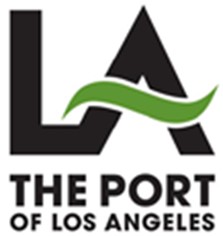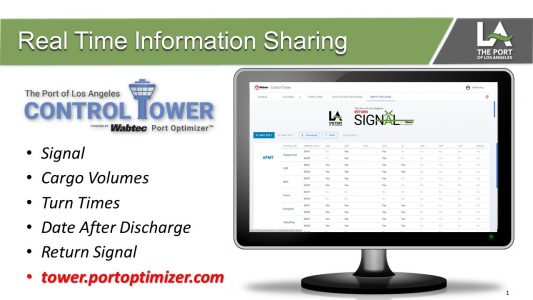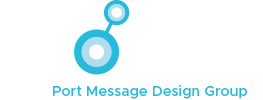

High demand: Los Angeles
The Port of Los Angeles has been busy – that would be an understatement. There has been plenty of publicity about delays in delivering cargo and congestion at the port, the direct result of extremely high demand for all manner of imported goods in combination with issues caused by Covid-19.
However, Eric Caris, LA’s director of cargo marketing, says it is important to emphasise that the marine terminals have been successfully handling record volumes. LA’s Port Community System (PCS), called the ‘Port Optimizer’, has a crucial role in helping keeping those volumes moving.
“The terminals are all very busy, with vessels laying at anchor,” he says. “Yes, the terminals are all busy and there is a level of frustration of people not able to pick up their boxes. But we are handling record volumes and record gate volumes. Cargo is moving.”
The port rolled out an incentive program rewarding shipping lines that out performed the market, but on the condition that eligible shipping lines provide data in to the Port Optimizer™. The Port does not only want volume – it wants cargo to move in the most efficient way possible, he says. “The way to do that is to make the relevant data available through the Port Optimizer™, providing transparency and visibility for all those involved in moving the cargo, whether by road, rail or water.”
In specifying, implementing and further developing the Port Optimizer™, the Port of Los Angeles is taking a broad outlook in terms of connectivity. “When we first put our digital strategy together, we wanted to provide a tool that would help all stakeholders in the supply chain to manage their business better,” says Eric. “It became clear that we needed a digital tool that made all the data available in one place.
“First this had to do with cargo visibility – knowing what is coming our way in terms of cargo type and size, whether local or intermodal, and so on. Following on from this, it would then allow chassis providers to plan ahead, and railroads could also use this information to make sure the railcars are positioned in the right place at the right time. And shippers can track a particular box to find out if it has been cleared/discharged/outgated, where it is now, and so on.”

As a landlord port Los Angeles does not operate the terminals, but it is very engaged with customers, including beneficial cargo owners, says Eric. “We are a business port, a sort of hybrid, working to support what is a crucial gateway and make sure services work well for all.”
After inviting bids, LA selected Wabtec Corporation to develop the Port Optimizer. The system has been steadily rolled out for use by BCOs, chassis providers, truckers, railroads, terminals, shipping lines and others. Use of the PCS is not compulsory but there are strong incentives for doing so.
“Shipping lines will typically create a ‘peel-off’ stack of containers for big importers, to avoid digging out boxes from many stacks,” says Eric. “Through the Port Optimizer, if the trucking company or cargo owner was able to assign trucks early on before the vessel arrives, and the terminal has visibility to that, then the terminal could even create peel-off piles by trucking company.”
The system incorporates road, rail and marine elements. Not only does it allow better visibility and predictability, it also allows users to download and analyse aspects of their operations later on, to identify where improvements can be made.
The Port Optimizer™ includes The Signal, which gives an advanced view compared to the previous week or year. A recent addition has been ‘Return Signal’, which gives the trucking community the ability to see, in one place, which terminals are accepting empty containers for which shipping line, reasons why empties are not being accepted and historical data for billing and other processing.
Through the Port Optimizer™’s Control Tower function, users can gather detailed information weekly on volumes and cargo flows in order to analyse and optimise – for example, monitoring average anchorage time, vessels due to anchor, how long boxes are dwelling in the terminal, and so on. “You can take action on the back of the statistics gathered through Control Tower – a supply chain stakeholder may see certain stress points and take appropriate action,” says Eric.
The Port Optimizer™ is also working with rail operators to integrate rail data; this will benefit terminal operators, which will be able see what volumes are coming their way by rail.
Much more is planned – a key objective is to create a central, universal truck booking system. This would enable a truck operator to book all necessary slots in one place, instead of visiting separate terminals’ websites. “This is a complex challenge but it is where APIs can come into place,” says Eric.
He recognises that the individual terminal operators have their own sophisticated IT systems in place – and, also, that shipping lines and terminals want to retain the ability to differentiate themselves, “to do better than their neighbour”.
“They are generally very supportive of the Port Optimizer™ but at the same time they fear they might lose some of their identity; we need to have some conversations about what can be achieved together. Ultimately, Wabtec are the aggregators of the data but neither they nor we own the data. We are looking for the benefits of creating connectivity in the right ways.”
LA is also considering how it can work with other regional entities – for example, related to traffic flows and local truck route optimisation. “It’s early days, but these are in the thought process,” he says.
All PCSs do different things in different ways; for example, some cover Customs clearance and navigational issues, which the Port Optimizer™ does not, says Eric. However, the common denominator for all PCSs is using data to make cargo flow more efficiently. The Port of Los Angeles’ dominant route is transpacific; it is a gateway port and does not handle transhipment, and that influences what is required from the PCS. “Our focus is on cargo visibility, tracking and tracing, and being able to take action.”



